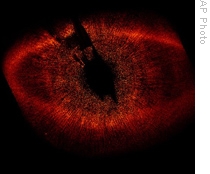VOA慢速英语 2008 1223b
时间:2018-12-01 作者:英语课 分类:VOA慢速英语2008年(十二)月
This is SCIENCE IN THE NEWS in VOA Special English. I'm Bob Doughty 1.
VOICE TWO:
And I'm Barbara Klein. This week, we will tell about planets orbiting stars other than the Sun. We will remember a huge disaster that struck four years ago. And we will tell how someone you never met can make you happy.
(MUSIC)
VOICE ONE:
The picture that astronomers 3 are creating of our universe has gotten a little more detailed 4. Last month, three teams of astronomers reported making direct images of planets orbiting other stars. Their observations are changing the way space scientists look at the universe.
Technological 5 progress has made finding planets far from our own solar system common. The first discovery was confirmed in nineteen ninety-four. Today, more than three hundred twenty planets have been discovered beyond our solar system.
To make these discoveries, scientists looked for small movements in nearby stars. The movements show the gravitational influence of another object on the star.

A NASA image shows a dust ring, seen in red, surrounding the star Fomalhaut, which is not visible in the photo. The planet Fomalhaut b is a small white spot in the lower right area of the dust ring.
Some planets have been found because they pass in front of the stars they orbit. This limits the amount of light seen on Earth for a short time.
VOICE TWO:
What is new about the recent observations is that they are direct images of distant planets. That is something astronomers once thought would never be possible.
One team was led by Christian 6 Marois, an astronomer 2 at the Herzberg Institute of Astrophysics in Victoria, Canada. His group found three planets orbiting a star called HR Eight Seven Nine Nine. The star is about one hundred thirty light years from Earth in the constellation 7, or group of stars, known as Pegasus.
VOICE ONE:
The team used the Keck Two and Gemini telescopes in Hawaii to produce the image showing the planets. The scientists also used a special technology called adaptive optics.
It changes the shape of a telescope's mirror to cancel the effects of the Earth's atmosphere. This permits clearer, higher quality images to be made.
The planets are huge. Two of them are ten times the mass of Jupiter -- the largest planet in our solar system. This puts them near the mass, not of planets, but of failed stars called brown dwarfs 8. However, there is evidence that supports the idea that they are planets.
Bruce Macintosh of Lawrence Livermore National Laboratory helped make the discoveries. He says all three objects orbit their star in the same direction and plane -- the way planets do.
VOICE TWO:
A second team announced the discovery of one planet orbiting the star Fomalhaut. Fomalhaut is the eighteenth brightest star in the sky. Paul Kalas of the University of California led a team that used the Hubble Space Telescope to find the planet now called Fomalhaut b. It took several years of observations to confirm its existence.
The planet is so distant from its star that it takes eight hundred seventy-two years to orbit Fomalhaut once.
Mister Kalas says Fomalhaut b orbits its star at the inside edge of a huge flattened 9 ring of ice and dust. This disk is similar to the Kuiper Belt, which surrounds our own solar system.
VOICE ONE:
A week after the announcements by the two teams, a French team announced that it had directly imaged a planet.
Ann-Marie Lagrange of the University of Grenoble led a team that used the Very Large Telescope operated by the European Southern Observatory 10 in Chile. The astronomers found the planet orbiting Beta Pictoris, a star sixty-three light years away.
The planet has not been seen long enough for astronomers to know its orbital period. But the researchers believe they have confirmed its planetary nature. They believe it is about eight times the mass of Jupiter.
(MUSIC)
VOICE TWO:
December twenty-sixth marks the anniversary of one of the worst natural disasters in recorded history. On that date four years ago, an underwater earthquake in the Indian Ocean formed a tsunami 11. The earthquake and waves from the tsunami killed an estimated two hundred thirty thousand people in eleven countries.
Western Indonesia suffered most from the tsunami. The waves struck the area about fifteen minutes after the earthquake. From the coast to far inland, one hundred forty thousand unsuspecting people were killed. The event also robbed Indonesia of valuable land.
No major tsunami had been recorded in the area for hundreds of years. But new evidence shows that other such deadly events may have taken place there long ago.
VOICE ONE:
Recently, a Norwegian scientist reported that a major tsunami may have struck the Indian Ocean between six hundred and seven hundred years ago. Stein Bondevik teaches at two universities in Norway. Two teams provided the information he presented. His report and their studies all appeared in the publication Nature.
A team in Thailand reported finding evidence of a tsunami striking that country a few centuries ago. Kruawun Jankaew works at Chulalongkorn University. Her team found sand material that represents a tsunami from six hundred to seven hundred years ago.
The other team was led by Katrin Monecke of Kent State University in the United States. Her team unearthed 12 evidence in the Indonesian island of Sumatra. Team members found sand material from the tsunami in two thousand four. They also found evidence of three tsunamis 13 from the past one thousand two hundred years. One of these may be the same event that hit Thailand six to seven centuries ago.
(MUSIC)
VOICE TWO:

Are you happy? Are your friends happy?
Are you feeling blue? An American study suggests that being surrounded by happy friends and neighbors could have more of an effect on your happiness than money. That is the finding of researchers from Harvard University and the University of California at San Diego.
Nicholas Christakis and James Fowler studied the emotional health of more than four thousand seven hundred people. They used information from the Framingham Heart Study. That study began sixty years ago in the American community of Framingham, Massachusetts. It was started to learn more about the risks of heart attack and stroke.
VOICE ONE:
For the new study, the researchers examined the emotions of the men and women in the Framingham Heart Study. The information was gathered from nineteen eighty-three to two thousand three.
The researchers found that friends of happy people had a greater chance of being happy themselves. That means that happiness spreads, or has a contagious 14 effect, among people. And, the smaller the physical distance between friends, the larger the effect they had on each other's happiness.
VOICE TWO:
For example, a person was twenty percent more likely to feel happy if a friend living within one and a half kilometers is also happy. Having happy a neighbor who lived next door increased an individual's chance of being happy by thirty-four percent. The effects of friends' happiness lasted for up to a year.
Sadness was also contagious among friends, but not as much as happiness. The researchers say social groups did not influence happiness as much as personal situations.
However, people removed by as much as three degrees of separation still had an effect on one's happiness. The expression three degrees of separation means the friends of the friends of an individual's friends.
In fact, persons with three degrees of separation had a greater effect on an individual's happiness than having five thousand dollars. The researchers say the study is historic because it shows that social effects on health can be spread among people.
VOICE ONE:
Another finding is that people who work together or are married do not have as much of an effect on happiness levels as friends. The researchers say this is often true among friends of the same sex.
A report on the findings was published this month in the British Medical Journal. America's National Institute on Aging helped to pay for the study.
Some researchers who were not involved with the study questioned its findings. They say the results could be disputed unless a separate study shows similar findings.
(MUSIC)
VOICE TWO:
This SCIENCE IN THE NEWS was written by Mario Ritter, Jerilyn Watson and Brianna Blake, who was also our producer. I'm Barbara Klein.
VOICE ONE:
And I'm Bob Doughty. Read and listen to our programs at voaspecialenglish.com. Join us again next week for more news about science in Special English on the Voice of America.
- Most of successful men have the characteristics of contumacy and doughty.绝大多数成功人士都有共同的特质:脾气倔强,性格刚强。
- The doughty old man battled his illness with fierce determination.坚强的老人用巨大毅力与疾病作斗争。
- A new star attracted the notice of the astronomer.新发现的一颗星引起了那位天文学家的注意。
- He is reputed to have been a good astronomer.他以一个优秀的天文学者闻名于世。
- Astronomers can accurately foretell the date,time,and length of future eclipses. 天文学家能精确地预告未来日食月食的日期、时刻和时长。 来自《简明英汉词典》
- Astronomers used to ask why only Saturn has rings. 天文学家们过去一直感到奇怪,为什么只有土星有光环。 来自《简明英汉词典》
- He had made a detailed study of the terrain.他对地形作了缜密的研究。
- A detailed list of our publications is available on request.我们的出版物有一份详细的目录备索。
- A successful company must keep up with the pace of technological change.一家成功的公司必须得跟上技术变革的步伐。
- Today,the pace of life is increasing with technological advancements.当今, 随着科技进步,生活节奏不断增快。
- They always addressed each other by their Christian name.他们总是以教名互相称呼。
- His mother is a sincere Christian.他母亲是个虔诚的基督教徒。
- A constellation is a pattern of stars as seen from the earth. 一个星座只是从地球上看到的某些恒星的一种样子。
- The Big Dipper is not by itself a constellation. 北斗七星本身不是一个星座。
- Shakespeare dwarfs other dramatists. 莎士比亚使其他剧作家相形见绌。 来自《简明英汉词典》
- The new building dwarfs all the other buildings in the town. 新大楼使城里所有其他建筑物都显得矮小了。 来自辞典例句
- She flattened her nose and lips against the window. 她把鼻子和嘴唇紧贴着窗户。
- I flattened myself against the wall to let them pass. 我身体紧靠着墙让他们通过。
- Guy's house was close to the observatory.盖伊的房子离天文台很近。
- Officials from Greenwich Observatory have the clock checked twice a day.格林威治天文台的职员们每天对大钟检查两次。
- Powerful quake sparks tsunami warning in Japan.大地震触发了日本的海啸预警。
- Coastlines all around the Indian Ocean inundated by a huge tsunami.大海啸把印度洋沿岸地区都淹没了。
- Many unearthed cultural relics are set forth in the exhibition hall. 展览馆里陈列着许多出土文物。
- Some utensils were in a state of decay when they were unearthed. 有些器皿在出土时已经残破。
- Our oceans are alive with earthquakes, volcanoes, and more recently, tsunamis. 海中充满着地震、火山,包括最近发生的海啸。 来自常春藤生活英语杂志-2006年2月号
- Please tell me something more about tsunamis! 请您给我讲讲海啸吧! 来自辞典例句
- It's a highly contagious infection.这种病极易传染。
- He's got a contagious laugh.他的笑富有感染力。